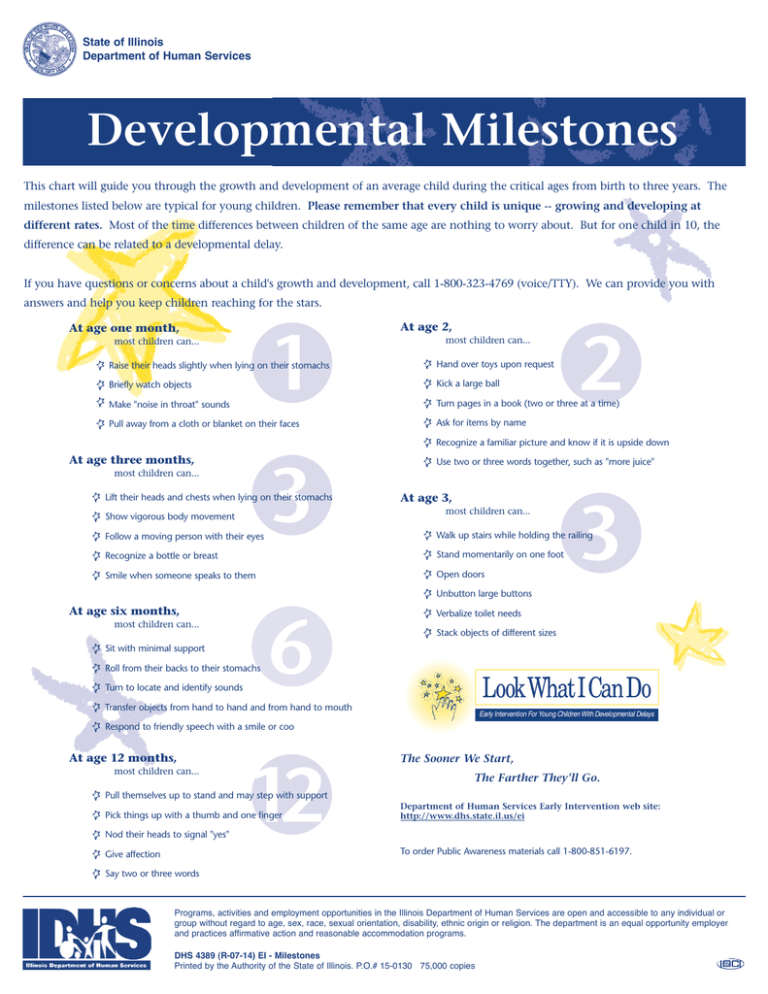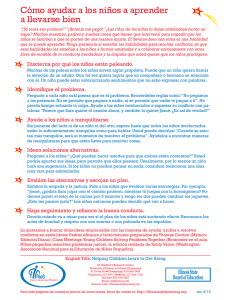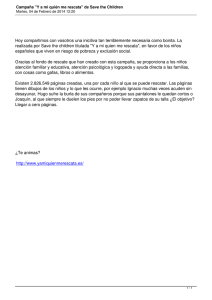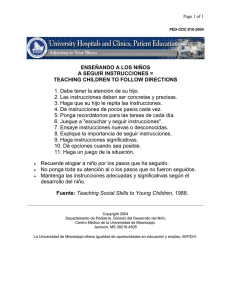DHS 4389 Developmental Milestones
Anuncio

State of Illinois Department of Human Services Developmental Milestones This chart will guide you through the growth and development of an average child during the critical ages from birth to three years. The milestones listed below are typical for young children. Please remember that every child is unique -- growing and developing at different rates. Most of the time differences between children of the same age are nothing to worry about. But for one child in 10, the difference can be related to a developmental delay. If you have questions or concerns about a child's growth and development, call 1-800-323-4769 (voice/TTY). We can provide you with answers and help you keep children reaching for the stars. At age 2, At age one month, 1 most children can... most children can... Raise their heads slightly when lying on their stomachs Hand over toys upon request Briefly watch objects Kick a large ball Make "noise in throat" sounds Pull away from a cloth or blanket on their faces 2 Turn pages in a book (two or three at a time) Ask for items by name Recognize a familiar picture and know if it is upside down At age three months, most children can... 3 Lift their heads and chests when lying on their stomachs Show vigorous body movement Follow a moving person with their eyes Use two or three words together, such as "more juice" At age 3, most children can... 3 Walk up stairs while holding the railing Recognize a bottle or breast Stand momentarily on one foot Smile when someone speaks to them Open doors Unbutton large buttons At age six months, most children can... Sit with minimal support Roll from their backs to their stomachs Turn to locate and identify sounds 6 Verbalize toilet needs Stack objects of different sizes Transfer objects from hand to hand and from hand to mouth Early Intervention For Young Children With Developmental Delays Respond to friendly speech with a smile or coo At age 12 months, most children can... The Sooner We Start, 12 The Farther They'll Go. Pull themselves up to stand and may step with support Pick things up with a thumb and one finger Nod their heads to signal "yes" Department of Human Services Early Intervention web site: http://www.dhs.state.il.us/ei To order Public Awareness materials call 1-800-851-6197. Give affection Say two or three words Programs, activities and employment opportunities in the Illinois Department of Human Services are open and accessible to any individual or group without regard to age, sex, race, sexual orientation, disability, ethnic origin or religion. The department is an equal opportunity employer and practices affirmative action and reasonable accommodation programs. DHS 4389 (R-07-14) EI - Milestones Printed by the Authority of the State of Illinois. P.O.# 15-0130 75,000 copies Estado de Illinois Departamento de Servicios Humanos Pilares del Desarrollo Este cuadro le guiará en el crecimiento y desarrollo de un niño durante las edades críticas desde el nacimiento hasta la edad de tres años. Los pilares del desarrollo anotados a continuación son típicos en los niños de edad temprana. Por favor recuerde que cada niño es único - crece y se desarrolla a diferentes ritmos. La mayoría del tiempo las diferencias entre niños de la misma edad no son para preocuparse. Pero en un niño de cada diez, la diferencia puede ser relacionada a un retrazo en el desarrollo. Si usted tiene preguntas o preocupaciones acerca del crecimiento y desarrollo de un niño, llame gratis al 1-800-323-4769 (voz / TTY). Podemos darle respuestas a sus preguntas y ayudar a los niños a que alcancen las estrellas. A la edad de un mes, la mayoría de los niños pueden... 1 A la edad de 2, la mayoría de los niños pueden... Levantar la cabeza algo cuando está echado de barriga Dar juguetes cuando se los piden Observar objetos brevemente Patear una pelota grande Hacer sonidos "ruidos en la garganta" Quitarse las coberturas de la cara 2 Voltear páginas de un libro (dos o tres a la vez) Pedir cosas por su nombre Reconocer un retrato familiar y saber si está boca arriba A la edad de tres meses, 3 la mayoría de los niños pueden... Levantar la cabeza y el pecho cuando están echados de barriga Demostrar movimientos de cuerpo con vigor Usar dos o tres palabras juntas, tal como "más jugo" A la edad de 3, la mayoría de los niños pueden... 3 Seguir el movimiento de las personas con los ojos Subir escaleras agarrándose de la baranda Reconocer el biberón o seno Pararse momentáneamente en un pie Sonreir cuando alguien les habla Abrir puertas Desabotonar botones grandes A la edad de seis meses, Expresar sus necesidades para ir al baño la mayoría de los niños pueden... Sentarse con mínimo apoyo Voltearse de espalda a barriga Voltear para ubicar e identificar sonidos 6 Acomodar objetos de diferentes tamaños Transferir objetos de una mano a otra y de la mano a la boca Responder a voces conocidas sonriendo Early Intervention For Young Children With Developmental Delays A la edad de 12 meses, la mayoría de los niños pueden... Pararse y dar pasos con apoyo Recoger cosas con un dedo Señalar que sí con la cabeza 12 Mientras más rápido empezamos, Llegarán más lejos. Sitioweb para IntervenciónTemprana del Departamento de Servicios Humanos: http://www.dhs.state.il.us/ei Dar cariño Decir dos o tres palabras Para pedir materiales para el público llame al 1-800-851-6197. Los programas, actividades y oportunidades de empleo con el Departamento de Servicios Humanos de Illinois están disponibles y son accesibles a cualquier individuo o grupo sin considerar la edad, sexo, raza, orientación sexual, discapacidad, origen étnico o religión. El departamento es un empleador que ofrece igualdad de oportunidad de empleo, practica acción afirmativa y tiene programas para acomodar razonablemente sus necesidades.






